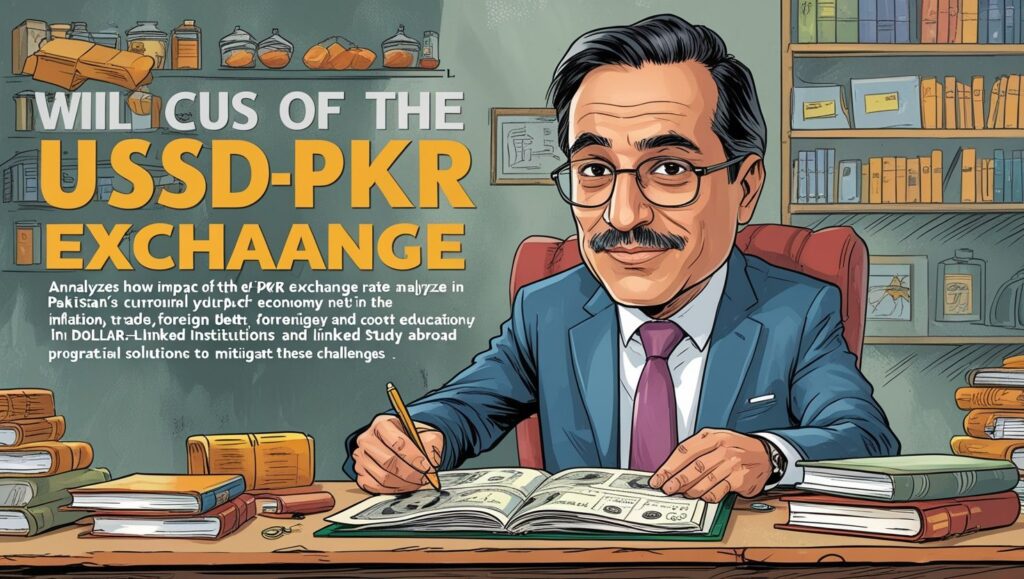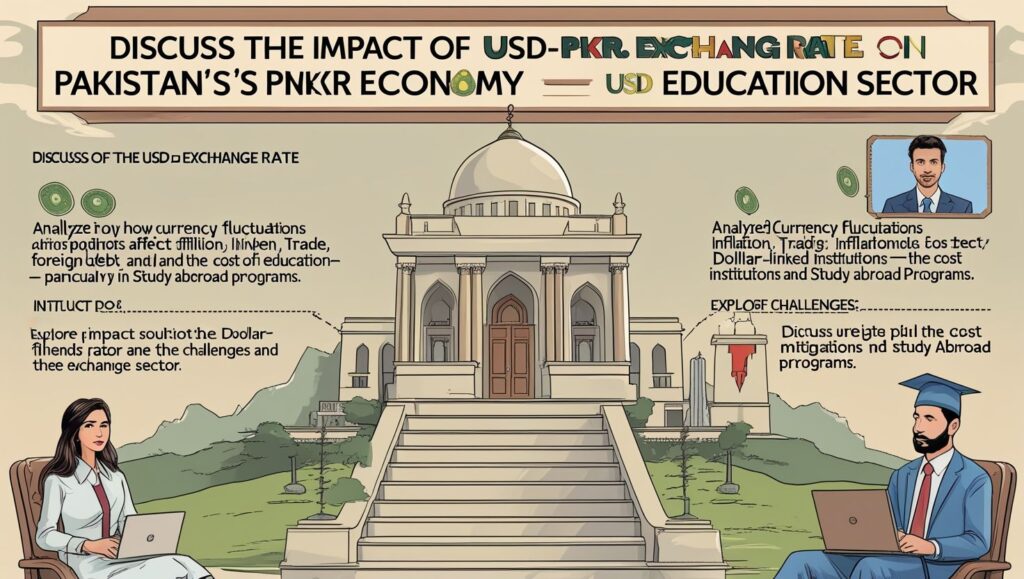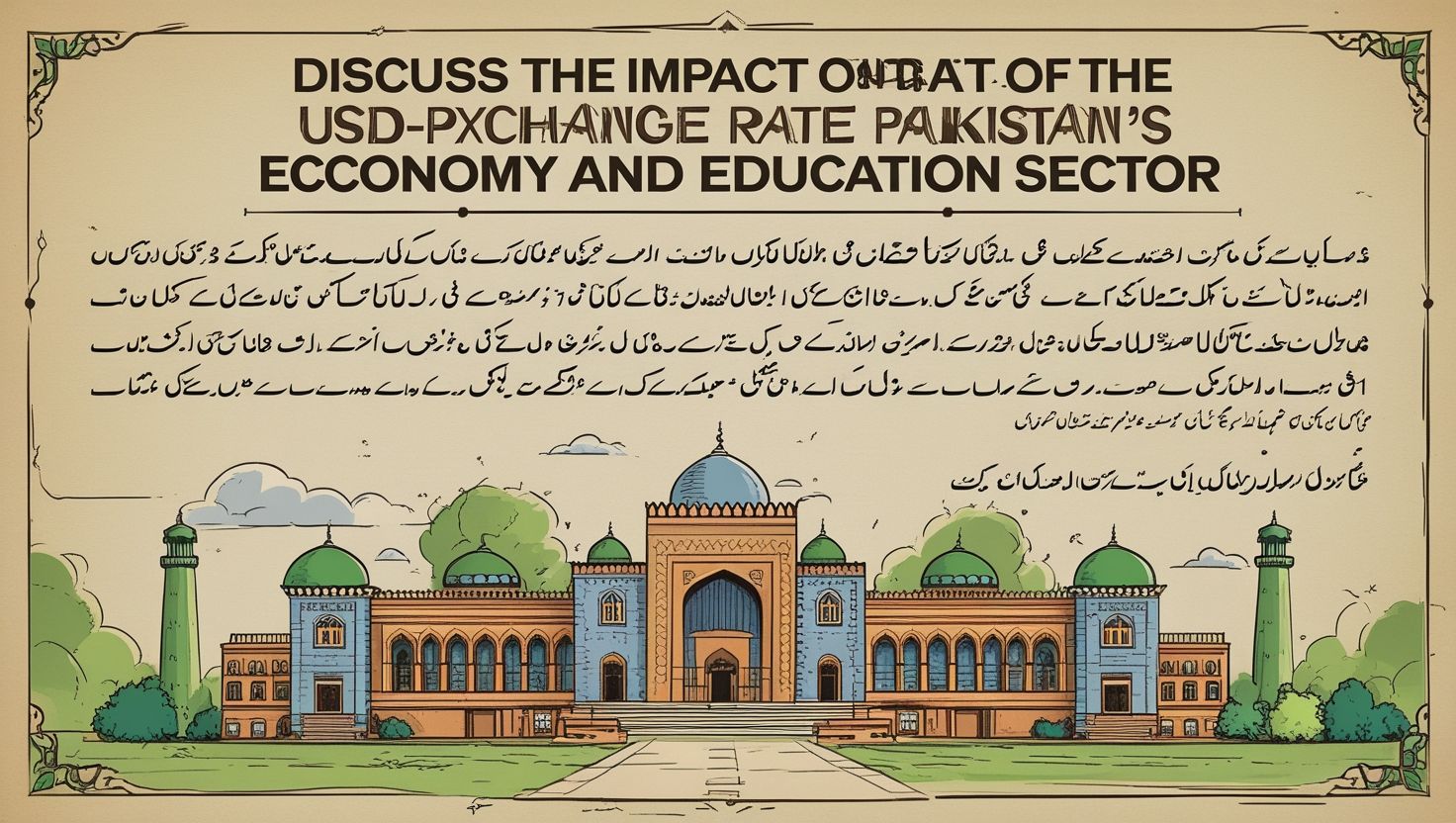Introduction
Dollar vs. PKR: Impact on Pakistan’s Economy and Education, The exchange rate between the US Dollar (USD) and the Pakistani Rupee (PKR) plays a pivotal role in shaping Pakistan’s economic landscape. Fluctuations in the USD-PKR exchange rate influence trade, inflation, foreign investments, and even the education sector. Given Pakistan’s reliance on imports, foreign debt, and remittances, the strength of the PKR against the dollar directly impacts the country’s financial stability.
This article explores the dynamics of the USD-PKR exchange rate, its economic implications, and its specific effects on Pakistan’s education system. From rising tuition fees in dollar-linked institutions to the affordability of study abroad programs, the currency exchange rate significantly influences educational opportunities for Pakistani students.
Exchange Rate Dynamics
The exchange rate between the USD and PKR is determined by supply and demand in the foreign exchange market. Key factors influencing this rate include:
- Trade Imbalance: Pakistan imports more than it exports, increasing demand for dollars and weakening the PKR.
- Foreign Reserves: Limited reserves restrict the State Bank of Pakistan’s (SBP) ability to stabilize the rupee.
- Inflation & Interest Rates: High inflation and interest rate adjustments affect currency value.
- Global Economic Trends: US Federal Reserve policies, oil prices, and geopolitical events also impact the exchange rate.

Economic Impact on Pakistan
A depreciating PKR has far-reaching consequences:
- Higher Import Costs: Pakistan relies on imported fuel, machinery, and technology, making essential goods more expensive.
- Export Competitiveness: A weaker rupee benefits exporters (e.g., textiles) by making Pakistani goods cheaper abroad.
- Inflation & Purchasing Power: Rising import costs lead to inflation, reducing household purchasing power.
- Foreign Debt Burden: Since Pakistan borrows in dollars, a weaker PKR increases debt repayment costs.
Impact on Education
The USD-PKR exchange rate directly affects Pakistan’s education sector in multiple ways:
1. Rising Tuition Fees in Dollar-Linked Institutions
Many private universities and international schools in Pakistan charge fees in USD or adjust them based on dollar rates. As the PKR depreciates, tuition becomes more expensive, limiting access to quality education for middle-class families.
2. Study Abroad Challenges
Pakistani students aspiring to study in the US, UK, or other foreign countries face higher costs due to a weaker rupee. Expenses such as tuition, accommodation, and living costs increase significantly, making education abroad less affordable.
3. Cost of Educational Materials
Books, research journals, and online learning resources priced in dollars become more expensive. Universities and students struggle with rising costs for academic materials.
4. Faculty Salaries & Research Funding
International faculty and research collaborations often involve dollar transactions. A declining PKR strains university budgets, affecting salaries and research grants.
5. Decline in Foreign Scholarships
Many foreign scholarships fix stipends in USD. If the PKR loses value, the real income of scholarship recipients decreases, making it harder to cover expenses.

Role of the State Bank & Government Policies
The SBP intervenes to stabilize the PKR through monetary policies, such as adjusting interest rates and managing forex reserves. The government can also mitigate education-related challenges by:
- Subsidizing Education: Offering relief to students in dollar-linked institutions.
- Encouraging Local Alternatives: Promoting affordable local universities to reduce reliance on foreign education.
- Stabilizing the Economy: Long-term policies to strengthen the PKR and control inflation.
Conclusion
The USD-PKR exchange rate is more than just a financial metric—it shapes Pakistan’s economic stability and access to education. A depreciating rupee increases the cost of education, both locally and abroad, creating barriers for students. While a weaker PKR may boost exports, its negative impact on inflation and purchasing power disproportionately affects students and families.
To ensure sustainable growth, Pakistan must implement policies that stabilize the currency, support affordable education, and reduce dependency on dollar-linked expenses. By addressing these challenges, the country can create a more resilient education system that remains accessible despite economic fluctuations.

I don’t think the title of your article matches the content lol. Just kidding, mainly because I had some doubts after reading the article.
284mrz
Can you be more specific about the content of your article? After reading it, I still have some doubts. Hope you can help me.
rru409
I think you have noted some very interesting points, thanks for the post.
Can you be more specific about the content of your article? After reading it, I still have some doubts. Hope you can help me.
I’d have to test with you here. Which isn’t something I often do! I take pleasure in studying a submit that may make people think. Also, thanks for permitting me to comment!
Thank you for your sharing. I am worried that I lack creative ideas. It is your article that makes me full of hope. Thank you. But, I have a question, can you help me?
Your point of view caught my eye and was very interesting. Thanks. I have a question for you.
Your article helped me a lot, is there any more related content? Thanks!
What i do not realize is actually how you’re not really a lot more smartly-liked than you may be now. You’re very intelligent. You recognize thus significantly in relation to this topic, produced me individually consider it from numerous numerous angles. Its like women and men aren’t interested except it is one thing to accomplish with Lady gaga! Your personal stuffs nice. At all times maintain it up!
Great post. I was checking constantly this weblog and I am inspired! Extremely useful information specially the final part 🙂 I handle such information much. I was looking for this certain info for a long time. Thanks and good luck.
An impressive share, I just given this onto a colleague who was doing a little analysis on this. And he in fact bought me breakfast because I found it for him.. smile. So let me reword that: Thnx for the treat! But yeah Thnkx for spending the time to discuss this, I feel strongly about it and love reading more on this topic. If possible, as you become expertise, would you mind updating your blog with more details? It is highly helpful for me. Big thumb up for this blog post!
Lovely just what I was searching for.Thanks to the author for taking his time on this one.
Its like you read my mind! You seem to understand a lot about this, like you wrote the ebook in it or something. I believe that you just could do with some p.c. to power the message home a bit, however instead of that, that is great blog. A fantastic read. I’ll certainly be back.
Can you be more specific about the content of your article? After reading it, I still have some doubts. Hope you can help me. https://www.binance.com/kz/register?ref=RQUR4BEO
Hi my family member! I want to say that this post is amazing, great written and come with approximately all important infos. I would like to look extra posts like this.
I would like to thnkx for the efforts you have put in writing this blog. I am hoping the same high-grade blog post from you in the upcoming as well. In fact your creative writing abilities has inspired me to get my own blog now. Really the blogging is spreading its wings quickly. Your write up is a good example of it.
Hello. Great job. I did not anticipate this. This is a impressive story. Thanks!
I feel this is one of the so much important info for me. And i am satisfied reading your article. But want to commentary on some common issues, The site style is great, the articles is truly nice : D. Excellent process, cheers
Can you be more specific about the content of your article? After reading it, I still have some doubts. Hope you can help me.
Thank you for your sharing. I am worried that I lack creative ideas. It is your article that makes me full of hope. Thank you. But, I have a question, can you help me?
Keep up the great piece of work, I read few posts on this web site and I believe that your site is really interesting and holds lots of wonderful information.
You are my inhalation, I own few web logs and infrequently run out from to brand.
Your article helped me a lot, is there any more related content? Thanks!